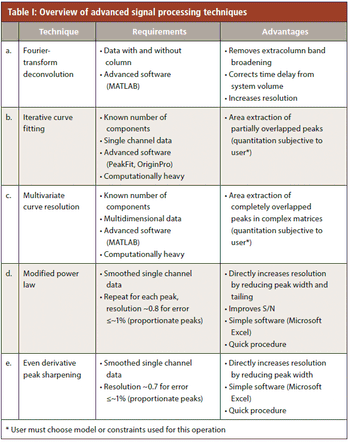Articles by Daniel W. Armstrong

Separation scientists frequently encounter critical pairs that are difficult to separate in a complex mixture. To save time and expensive solvents, an effective alternative to conventional screening protocols or mathematical peak width reduction is called iterative curve fitting.

Small metabolic molecules often are chiral and can play important roles in regulating a variety of biological functions, occasionally providing information about the presence and progression of disease.

The advantages and limitations of several recently introduced mathematical procedures for enhancing peak resolution in liquid chromatography (LC) are described. Despite advanced separation technologies and extensive knowledge in method development, peak overlap is still commonly observed. This article gives a brief overview of the advantages and limitations of recently introduced mathematical procedures for enhancing resolution.

This article gives a brief overview of the advantages and limitations of recently introduced mathematical procedures such as the Fourier deconvolution of extracolumn effects, iterative curve fitting, multivariate curve resolution, modified power law, and use of first and second derivatives in enhancing resolution. High-throughput analyses in gas chromatography (GC), LC, and supercritical fluid chromatography (SFC) could benefit from these simple and effective approaches in many challenging separations applications.

We explore the developments that have made it possible to produce sub-minute, and, more recently, even sub-second enantiomeric separations. We also look at the questions that remain unanswered.

Compared to the progress made in reversed phase separations in terms of speed and efficiency, chiral chromatographers have traditionally focused on improving the selectivity of enantiomeric separations by synthetic procedures. As a result, more than 50 different types of advanced chiral stationary phase chemistries are available today. Traditionally, speed and efficiency of chiral chromatography has not received attention until recently. With the availability of superficially porous particles and sub-2-µm particles, sub-minute enantiomeric separations have been achieved with the help of improved particle technology with narrow size distribution, and systematic studies on packing columns. This article covers advances made in the field of ultrafast chiral chromatography in the last decade. The development of instrumentation technology has also contributed immensely to making sub-second chiral separations a reality. Enantiomeric separations can now compete with the speed of sensors. Future directions and unanswe

In advance of PittconIn advance of Pittcon 2018, leading scientists-Ronald Majors, Richard Henry, John W. Dolan, Zachary S. Breitbach, and Daniel W. Armstrong-who will be speaking at the LCGC awards symposium give us a preview of their talks.

Gaussian peak shapes in chromatography are indicative of a well-behaved system. Such peak shapes are highly desirable from the perspective of column packing technology. From an analyst’s point of view, Gaussian peaks provide improved sensitivity (lower detection limits) and allow ease of quantitation. In practice, one can obtain peaks that tail, front, or concurrently front and tail for reasons such as column packing issues, chemical and kinetic effects, and suboptimal high performance liquid chromatography (HPLC) system plumbing and detector settings. Here, we discuss a number of approaches for peak shape measurement that are available in modern chromatography software, along with their advantages and drawbacks. A new “total peak shape analysis” approach is suggested that facilitates detection and quantification of concurrent fronting and tailing in peaks. Several remediation approaches are proposed that can help chromatographers analyze and improve peak shapes.

A number of approaches for peak shape measurement are available in modern chromatography software. We discuss the advantages and drawbacks of those approaches, and present a new concept, “total peak shape analysis.”

An automated method for determination of water in liquid sweeteners was developed using headspace gas chromatography (GC) and ionic liquid-based capillary GC columns. This method allowed for the rapid determination of water with minimal sample pretreatment. In addition to providing fast analysis time for the samples, the headspace GC method was found to be accurate and precise for the measurement of water in 16 liquid sweeteners. This method was shown to be widely applicable for sugar and sugar-free sweeteners and more accurate than Karl Fischer titration.


An automated method for determination of water in liquid sweeteners was developed utilizing headspace gas chromatography (GC) and ionic liquid-based capillary GC columns. This method allowed for the rapid determination of water with minimal sample pretreatment. In addition to providing fast analysis time for the samples, the headspace GC method was found to be accurate and precise for the measurement of water in 16 liquid sweeteners. This method was shown to be widely applicable for sugar and sugarless based sweeteners and likely, more accurate than Karl Fischer titration.

The 39th International Symposium on Capillary Chromatography (ISCC) and the 12th GC×GC Symposium held in Fort Worth in Texas, USA, were rousing successes with nearly double the participation of the previous U.S. meetings

SFC was evaluated as an alternative to HPLC for the enantiomeric separation of primary amines on a cyclofructan-based CSP.

Supercritical (subcritical) fluid chromatography (SFC) was evaluated as an alternative to HPLC for the enantiomeric separation of primary amines on a cyclofructan-based chiral stationary phase.

Developing versatile, rapid, and accurate analytical techniques for the detection and quantification of water in a variety of materials remains an important and ubiquitous analytical problem. This article describes an effective and sensitive ionic liquid (IL)-based capillary gas chromatography (GC) method with thermal conductivity detection (TCD) to determine the water content in liquid samples.

Describing an accurate analytical technique for the detection and quantification of water using IL-based capillary GC.

This article discusses the unique properties of ILs and their potential impact as GC stationary phases.

Guest columnists explore how ionic liquids can be tweaked to mimic the popular stationary phases of today.

This article provides theoretical background, experimental data, and practical considerations about the effects of organic modifiers on analyte ionization in reversed-phase LC.

The authors evaluate a new chiroptical detector's sensitivity for various chiral compounds, linear dynamic range, and relative response with different solvents.


























